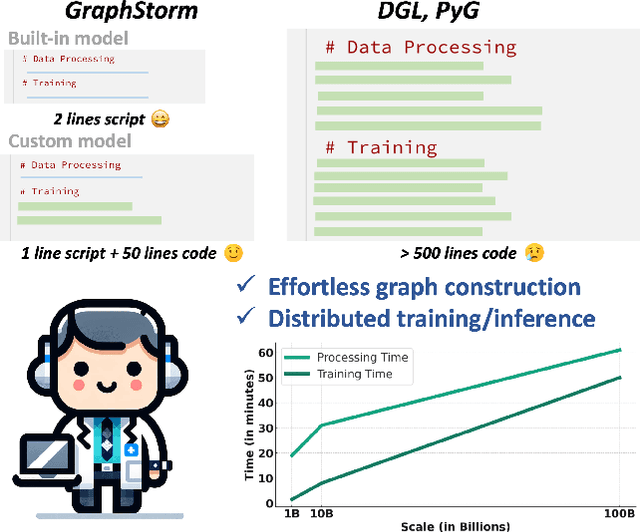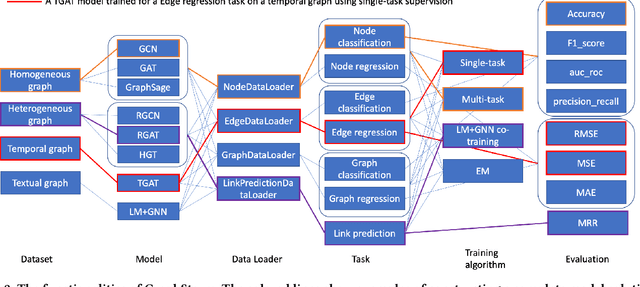Alejandro Mottini
GraphStorm: all-in-one graph machine learning framework for industry applications
Jun 10, 2024



Abstract:Graph machine learning (GML) is effective in many business applications. However, making GML easy to use and applicable to industry applications with massive datasets remain challenging. We developed GraphStorm, which provides an end-to-end solution for scalable graph construction, graph model training and inference. GraphStorm has the following desirable properties: (a) Easy to use: it can perform graph construction and model training and inference with just a single command; (b) Expert-friendly: GraphStorm contains many advanced GML modeling techniques to handle complex graph data and improve model performance; (c) Scalable: every component in GraphStorm can operate on graphs with billions of nodes and can scale model training and inference to different hardware without changing any code. GraphStorm has been used and deployed for over a dozen billion-scale industry applications after its release in May 2023. It is open-sourced in Github: https://github.com/awslabs/graphstorm.
Voicy: Zero-Shot Non-Parallel Voice Conversion in Noisy Reverberant Environments
Jun 16, 2021



Abstract:Voice Conversion (VC) is a technique that aims to transform the non-linguistic information of a source utterance to change the perceived identity of the speaker. While there is a rich literature on VC, most proposed methods are trained and evaluated on clean speech recordings. However, many acoustic environments are noisy and reverberant, severely restricting the applicability of popular VC methods to such scenarios. To address this limitation, we propose Voicy, a new VC framework particularly tailored for noisy speech. Our method, which is inspired by the de-noising auto-encoders framework, is comprised of four encoders (speaker, content, phonetic and acoustic-ASR) and one decoder. Importantly, Voicy is capable of performing non-parallel zero-shot VC, an important requirement for any VC system that needs to work on speakers not seen during training. We have validated our approach using a noisy reverberant version of the LibriSpeech dataset. Experimental results show that Voicy outperforms other tested VC techniques in terms of naturalness and target speaker similarity in noisy reverberant environments.
What Do You Mean I'm Funny? Personalizing the Joke Skill of a Voice-Controlled Virtual Assistant
Dec 06, 2019



Abstract:A considerable part of the success experienced by Voice-controlled virtual assistants (VVA) is due to the emotional and personalized experience they deliver, with humor being a key component in providing an engaging interaction. In this paper we describe methods used to improve the joke skill of a VVA through personalization. The first method, based on traditional NLP techniques, is robust and scalable. The others combine self-attentional network and multi-task learning to obtain better results, at the cost of added complexity. A significant challenge facing these systems is the lack of explicit user feedback needed to provide labels for the models. Instead, we explore the use of two implicit feedback-based labelling strategies. All models were evaluated on real production data. Online results show that models trained on any of the considered labels outperform a heuristic method, presenting a positive real-world impact on user satisfaction. Offline results suggest that the deep-learning approaches can improve the joke experience with respect to the other considered methods.
Airline Passenger Name Record Generation using Generative Adversarial Networks
Jul 17, 2018



Abstract:Passenger Name Records (PNRs) are at the heart of the travel industry. Created when an itinerary is booked, they contain travel and passenger information. It is usual for airlines and other actors in the industry to inter-exchange and access each other's PNR, creating the challenge of using them without infringing data ownership laws. To address this difficulty, we propose a method to generate realistic synthetic PNRs using Generative Adversarial Networks (GANs). Unlike other GAN applications, PNRs consist of categorical and numerical features with missing/NaN values, which makes the use of GANs challenging. We propose a solution based on Cram\'{e}r GANs, categorical feature embedding and a Cross-Net architecture. The method was tested on a real PNR dataset, and evaluated in terms of distribution matching, memorization, and performance of predictive models for two real business problems: client segmentation and passenger nationality prediction. Results show that the generated data matches well with the real PNRs without memorizing them, and that it can be used to train models for real business applications.
Deep Choice Model Using Pointer Networks for Airline Itinerary Prediction
Mar 15, 2018



Abstract:Travel providers such as airlines and on-line travel agents are becoming more and more interested in understanding how passengers choose among alternative itineraries when searching for flights. This knowledge helps them better display and adapt their offer, taking into account market conditions and customer needs. Some common applications are not only filtering and sorting alternatives, but also changing certain attributes in real-time (e.g., changing the price). In this paper, we concentrate with the problem of modeling air passenger choices of flight itineraries. This problem has historically been tackled using classical Discrete Choice Modelling techniques. Traditional statistical approaches, in particular the Multinomial Logit model (MNL), is widely used in industrial applications due to its simplicity and general good performance. However, MNL models present several shortcomings and assumptions that might not hold in real applications. To overcome these difficulties, we present a new choice model based on Pointer Networks. Given an input sequence, this type of deep neural architecture combines Recurrent Neural Networks with the Attention Mechanism to learn the conditional probability of an output whose values correspond to positions in an input sequence. Therefore, given a sequence of different alternatives presented to a customer, the model can learn to point to the one most likely to be chosen by the customer. The proposed method was evaluated on a real dataset that combines on-line user search logs and airline flight bookings. Experimental results show that the proposed model outperforms the traditional MNL model on several metrics.
 Add to Chrome
Add to Chrome Add to Firefox
Add to Firefox Add to Edge
Add to Edge